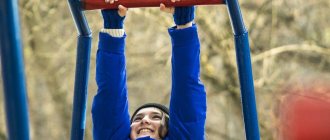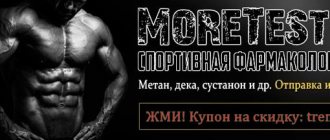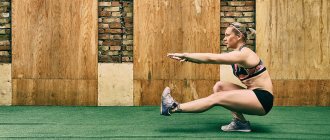Air squats are an essential part of any CrossFit training program. What does this buzzword mean? CrossFit is a high-interval training that includes elements of gymnastics, aerobics, strength training, kettlebell lifting, stretching and other types of physical activity.
Air squats are simple bodyweight squats, without additional weights. They are also called air squat or squat squats. The exercise is present in the warm-up complex of any workout; it helps to warm up the muscles, master the correct technique for performing squats, and develop endurance.
The main feature of the exercise is its “airiness” - it is performed exclusively with your own weight. That is why, in fact, classic squats in this case are called air squats.
What muscles are involved?
If you perform the air squat technique correctly, you will use the following muscle groups:
- Gluteus maximus;
- The front and back of the thighs;
- Biceps femoris;
- Calf muscles;
- Posterior muscles of the leg;
- Back and abdominal muscles as stabilizers.
Please note that these muscles work only if the technique is followed during the exercise. Improper execution can lead to dire consequences, especially in the future, when the athlete moves on to squats with weights.
Teaching the pushing technique
In sections, teaching the pushing technique begins, as a rule, with exercises with a shortened range of motion. First, they give exercises such as standing barbell presses and front squats.
Then they proceed to clean the barbell into a rack hanging from the hip and push the barbell from the racks. After the child has mastered the movements individually, they are allowed to perform the movement in a complex manner - a sit-up clean from the shin + a push. The classic clean and jerk is approached gradually and measuredly.
It is also worth noting that even experienced athletes often do not see their mistakes themselves - it is important to study this exercise under the supervision of a trainer, since only a trainer will be able to correct the technique in time and prevent injury.
Pros and cons of squat squats
Squat squats are very important for the body, let's look at what the benefits are:
- The athlete’s endurance threshold increases, which allows for improved standards in sports;
- Adequate exercise trains the cardiovascular system well;
- The lower part of the body takes the main hit, so ladies who want to improve the shape and appearance of their butt and hips, don’t forget about air squats!
- The exercise is performed at a fast pace, which promotes active fat burning;
- The flexibility of joints and ligaments increases, which is extremely important if an athlete plans to learn how to squat with heavy weight;
- The sense of balance is sharpened, coordination of movements improves.
We have talked about the benefits of air squats, then we will briefly discuss in what cases they can cause harm:
- Firstly, if you have joint problems, especially the knees, air squats can aggravate them. Note that in this case, any type of squats is basically contraindicated for the athlete.
- This exercise should not be practiced by overweight people;
- Contraindications also include diseases of the musculoskeletal column, heart, any inflammation, conditions after abdominal surgery, pregnancy.
If an athlete has chronic diseases, we recommend consulting with a supervising physician before starting training.
BURPEE. BURPEE
Technique for performing the exercise: “Burpee” - The initial position of the Burpee exercise is to lie down, push up from the floor, sharply pull your knees to your chest in a squat position and your hands touch the floor with your palms and jump up, making a light clap with your hands above your head. Return to starting position. As an option, instead of jumping up, jump forward, pushing off the floor with both feet at the same time.
Air squat variations
Air squats in CrossFit are performed in different ways, let's list the signs by which they can be divided:
- Deep and classic. The classic squat depth involves the lowest point of the exercise at the moment when the thighs become parallel to the floor. If the athlete goes even lower, the squat is considered deep;
- Depending on the placement of the feet, toes should be outward or parallel to each other. The wider the socks are turned out, the more the inner thigh is involved in the work.
- With wide or narrow legs. A narrow stance engages the front muscles of the thigh, while a wide stance targets the buttocks more.
BARBELL BENCH PRESS
Technique for performing the exercise: Lie down on a bench with your legs comfortably apart. Taking into account the peculiarities of the technique, we will describe not the “lifting” technique, but the classical one, in which the load falls largely on the muscles of the chest and triceps. The body on the bench lies completely pressed without bending in the lower back, elbows are pulled to the sides. The bar is lowered to the level of the sternum and returned to the outstretched arms to its original position.
Mistakes: Lifting your feet off the floor when performing a bench press. The elbows are tightly pressed to the torso, which steals the load from the pectoral muscles and overloads the deltoids and triceps. Don’t forget about breathing, breathing is done with effort.
How often should you exercise
Air squats should be included in every workout. Be sure to include them in your warm-up routine. We recommend doing at least 2 sets of 30-50 reps (depending on the athlete’s level of fitness). Gradually increase the load, up to 3 sets of 50 reps. The break between approaches is 2-3 minutes, the exercise is performed at a high tempo.
Frontal
This exercise is another variation of squats for men and women using a barbell that is placed on the deltoid muscle and chest. Less weight is used than in the previous version, the back is kept almost vertical, and this involves other muscles in the work - the back of the thigh and gluteals. It is vertical squats that are considered the best for pumping up the muscles of the buttocks. For beginners, this exercise can be avoided until a certain time; for them, standard squats without weights are much more important. Due to the specific location of the weight and the distribution of weight, in this case a greater load is placed on the knees than in the classic version of squats, so if you have problem knees, front squats should be avoided.
Execution technique and typical mistakes
Well, now we’ve come to the most important thing - let’s finally look at the technique of performing air squats.
- Did you forget about the warm-up? Warming up your muscles is very important!
- Starting position – feet shoulder-width apart (depending on the placement of the feet), back straight, toes and knees strictly in the same plane (touching the imaginary wall directly in front of you), look straight ahead;
- The arms are spread to the sides, held straight in front of you or crossed in a lock in front of the chest;
- As we inhale, we lower ourselves down, slightly moving our lower back back to the lowest point;
- As you exhale, we rise to the starting position.
Despite the fact that many people know how to do an air squat, there are common mistakes that negate the benefits of the exercise:
- The back should remain straight throughout all stages of the exercise. Rounding the spine puts unnecessary stress on the back;
- Your feet should not be lifted off the floor, otherwise you risk losing your balance or damaging your calf muscles (which is extremely risky when doing squats with a heavy barbell);
- Your knees should always point in the same direction as your toes. If the latter stand parallel, then the knees in a squat do not move apart and vice versa;
- The body weight should be evenly distributed on both legs to avoid damaging the hip and knee joints.
- Make sure you breathe correctly - move down as you inhale, and move up as you exhale.
As an alternative to air squats, we can recommend running in place, jumping rope, or leg swings.
Our publication has come to an end, now you know what air squats are and how to perform them correctly. We wish you to master the technique as soon as possible so that you can move on to strength exercises! New victories in the sports field!
Correct positioning of legs and body
When performing squats, it is important to control several key points:
- Throughout the entire exercise, your feet should be pressed firmly to the floor. No need to stand on your toes. This will allow you to properly distribute your body weight and thus improve your balance.
- In squats, the knees move strictly in the plane of the feet. That is, if your feet are parallel, then your knees are directed straight forward throughout the entire movement. If you point your toes out, your knees will also point out.
- The spine is fixed in one position. The gaze is directed forward, not down, the back is straight with a natural arch in the lower back. This position does not change until the end of the exercise. You cannot round your back and lower back. In squats without a barbell, it is much easier to work out this moment than with a barbell.
- Your hands are the most important part of your balance. You can spread them to the sides or hold them in front of you.
TURKISH RISE. TURKISH GET UP
Name RUS: Turkish Get Up Name ENG: Turkish Get Up Required: Kettlebell, Barbell Exercise technique: The Turkish get up with a kettlebell is an excellent functional exercise. When performing it, all the muscles of the body are involved, which must perform the work harmoniously and consistently. This exercise can be compared to the deadlift in bodybuilding. Anyone who is more or less seriously involved in bodybuilding knows that deadlifts can really increase strength in all exercises. Turkish get-up is a difficult exercise and not the most pleasant to perform, but if you want to increase the strength and power of the whole body, it is simply necessary to include it in your training.
Another undoubted advantage of this exercise is that it helps develop joint mobility. Performing a Turkish get-up with a kettlebell will help you improve your joint health, correct posture problems, and give you the cardio you need for a healthy heart.
POLISHER
ENG: Floor Wipers Type of exercise: Press (Sit-up, toes to the bar, etc.) Required: Barbell Technique: Starting position, lying on your back, hold the barbell with outstretched arms in front of you. We begin to raise our legs and touch the barbell with them, without changing the position of the barbell relative to the body.
Safety precautions: When lifting your legs, do not pick up high speed; you may hit your shin hard on the barbell.
PLANK
Name RUS: Plank Name ENG: Plank Type of exercise: Press (Sit-up, socks to the bar, etc.)
Starting position: There are a lot of varieties of planks, we will look at the classic scheme. The main position is lying on your elbows. The body is elongated in a straight line.
Safety precautions: the body is extended in a line without deflection or a “house” pose; if the plank is performed using a complicated technique, i.e. on one arm or with emphasis on one leg, then take care of your nose when you fall; there is very little time to react!
FARMER'S WALK. FARMER'S WALK
Required: Dumbbells, Kettlebell Technique for performing the exercise: Farmer's walk - walking for some distance with weights in your arms lowered along the body.
This can be done either on steps or on a flat surface. Safety precautions: When moving, try to choose a slow pace so as not to fall to the sides, do not allow the body to pendulum, that is, do not throw your shoulders in front and do not look at your feet.










